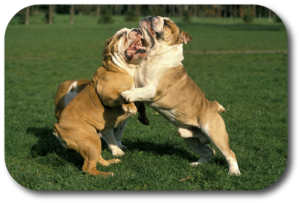A prior Home Dog Training Client from Canton recently called us and told us that his two English Bulldogs had been fine for several years. All of a sudden they have become aggressive and possessive between each other. Over the last week he had read a lot of articles regarding sibling rivalry between dogs. He said that he had he, his brother, and sister always had instances of sibling rivalry, but is it true this can take place with dogs?

Robin and I have often seen this, so the answer is “yes”. Canine sibling rivalry might only show itself as a simple snap and growl from time to time. It may also progress to a full out brawl almost every time the dogs get close to each other. This is something that should be dealt with as quickly as possible before it becomes dangerous for the dogs and family members.
- It is important that he keep his dogs separated until he is assured that the dogs no longer act on aggressive tenancies or display dominance posturing.
- Our client must be aware that the most important relationship that needs to be reestablished and strengthened is his relationship with his dogs. We reminded him that sibling rivalry is often caused because the owner has not demonstrated appropriate leadership.
- Distance control is a very important action he can individually practice with each dog. He needs to put a long training lead on each dog and then throw something the dog will run after. He next needs to gain the dog’s attention and have the dog come back to him. If he can’t easily get his dog’s attention, he can slightly tug on the training lead. This needs to be done with each dog individually.
- Sibling rivalry can also come about because one of the dogs feels that there has been a special relationship created between our client and the “other dog”. It is important that our client treats each dog equally.
- For the time being, our client should always have leashes on the dogs when they may come into close proximity. This will permit him to always be in control. If he views too much staring or posturing between one or both of the dogs, redirect them back to him and have the dog do something on his terms. He can have his dog sit in front of him and give him focus for a few moments. After that, he can release the dog and continue to observe. He should have another family member to the same with the other dog.
- Even if our client is not observing aggression between the two dogs when he is present, he should still crate them when he is gone. As their leader and protector, he can establish any environment he desires. For the present, and for their safety, has decided that they are crated when he is gone. This takes the opportunity for aggression away. It slowly enforces the learned and consistent behavior of “we don’t fight”.
- We reminded our client that he needs to enforce and strengthen his leadership position with his dogs. He doesn’t need to be “the bad guy”, he needs to be “resolute”. Body language signs that his dogs will display when they are respectful towards our client are:
- Head down
- ears back
- quick licking of the lips
- complete focus
As a final note: Always do this in a slow, consistent, and methodical way. Never put the dogs in a situation where you are not in complete control. You are in charge because you are their boss.
Please call Robin or me at (770) 718-7704 if you need any dog training help. We are blessed to have been your local dog training professionals for over fifteen years. We have trained over 5,000 great dogs and loving families and are ready to help you.

Follow Us!